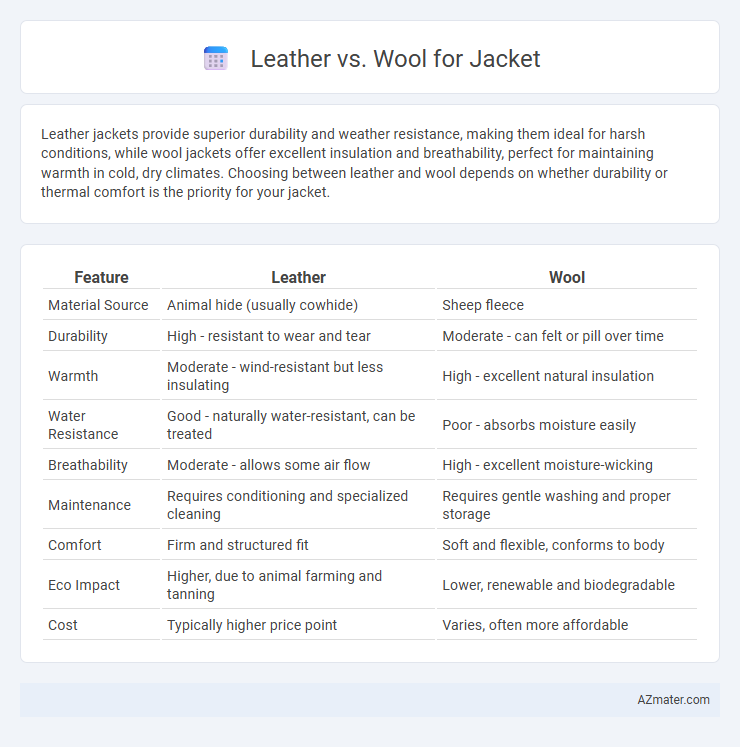Leather jackets provide superior durability and weather resistance, making them ideal for harsh conditions, while wool jackets offer excellent insulation and breathability, perfect for maintaining warmth in cold, dry climates. Choosing between leather and wool depends on whether durability or thermal comfort is the priority for your jacket.
Table of Comparison
| Feature | Leather | Wool |
|---|---|---|
| Material Source | Animal hide (usually cowhide) | Sheep fleece |
| Durability | High - resistant to wear and tear | Moderate - can felt or pill over time |
| Warmth | Moderate - wind-resistant but less insulating | High - excellent natural insulation |
| Water Resistance | Good - naturally water-resistant, can be treated | Poor - absorbs moisture easily |
| Breathability | Moderate - allows some air flow | High - excellent moisture-wicking |
| Maintenance | Requires conditioning and specialized cleaning | Requires gentle washing and proper storage |
| Comfort | Firm and structured fit | Soft and flexible, conforms to body |
| Eco Impact | Higher, due to animal farming and tanning | Lower, renewable and biodegradable |
| Cost | Typically higher price point | Varies, often more affordable |
Introduction: Leather vs Wool Jackets
Leather jackets offer durability, water resistance, and a sleek, edgy style ideal for both casual and semi-formal wear. Wool jackets provide superior insulation, breathability, and a classic, versatile look perfect for colder climates and formal settings. Choosing between leather and wool jackets depends on factors like weather conditions, desired comfort, and fashion preferences.
Material Overview: Leather and Wool Explained
Leather offers durability, water resistance, and a sleek appearance, making it ideal for rugged, stylish jackets. Wool provides excellent insulation, breathability, and natural moisture-wicking properties, suited for warmth and comfort in colder climates. Both materials vary significantly in texture, maintenance, and environmental impact, influencing jacket choice based on functionality and fashion preferences.
Durability Comparison: Which Lasts Longer?
Leather jackets typically offer superior durability compared to wool, as their dense fibers resist wear, moisture, and abrasion more effectively. High-quality leather can last for decades with proper care, maintaining its strength and appearance despite frequent use. Wool jackets, while warm and breathable, tend to degrade faster under constant friction and exposure to elements, making them less suitable for long-term, heavy-duty wear.
Comfort and Wearability
Leather jackets offer durability and wind resistance, making them ideal for cooler, windy weather but can feel stiff and less breathable during extended wear. Wool jackets provide superior insulation and moisture-wicking properties, ensuring warmth and comfort in colder climates while remaining soft and breathable for prolonged use. Choosing between leather and wool depends on desired comfort levels, breathability needs, and typical weather conditions for optimal wearability.
Weather Resistance: Rain, Wind, and Cold
Leather jackets offer superior wind resistance and moderate water resistance, making them effective in light rain and blustery conditions, but they require proper treatment to maintain waterproofing. Wool jackets excel in insulating warmth and moisture-wicking properties, providing excellent cold-weather comfort and natural resistance to light rain due to lanolin content. For harsh wet weather, treated leather outperforms untreated wool, while wool remains preferable for breathability and sustained warmth in dry, cold environments.
Style and Versatility
Leather jackets offer a sleek, edgy look that pairs well with casual and semi-formal outfits, making them a staple for urban and contemporary style enthusiasts. Wool jackets provide a classic, refined appearance ideal for colder climates, lending warmth and sophistication suitable for both business and casual settings. Both materials enhance jacket versatility, with leather excelling in durability and bold fashion statements, while wool delivers comfort and timeless elegance.
Maintenance and Care Requirements
Leather jackets require regular cleaning with specialized leather conditioners and should be kept away from prolonged exposure to moisture to prevent cracking and fading. Wool jackets demand gentle washing or dry cleaning to maintain fiber integrity and avoid shrinkage, along with proper storage to prevent moth damage. Both materials benefit from careful handling, but leather's surface changes necessitate more frequent attention, whereas wool relies heavily on correct cleaning methods to preserve its texture.
Ethical and Sustainability Considerations
Leather jackets often raise ethical concerns due to animal welfare issues and the environmental impact of livestock farming, including greenhouse gas emissions and deforestation. Wool jackets provide a renewable, biodegradable alternative, though ethical considerations depend on responsible sheep farming practices that avoid animal cruelty and land degradation. Choosing jackets made from certified sustainable wool or ethically sourced leather supports environmental protection and animal welfare.
Price Range and Value for Money
Leather jackets typically range from $150 to over $1,000, offering durability and a timeless style that increases their long-term value. Wool jackets, priced between $100 and $500, provide excellent warmth and comfort, making them a cost-effective choice for colder climates. Considering factors like longevity, maintenance, and seasonal use helps determine which material offers better value for money.
Choosing the Right Jacket for Your Needs
Leather jackets offer durability and wind resistance, making them ideal for motorcycle riding and cooler weather. Wool jackets provide superior insulation and breathability, perfect for cold climates and formal occasions. Selecting the right jacket depends on your activity level, climate, and style preferences to ensure comfort and practicality.

Infographic: Leather vs Wool for Jacket
 azmater.com
azmater.com